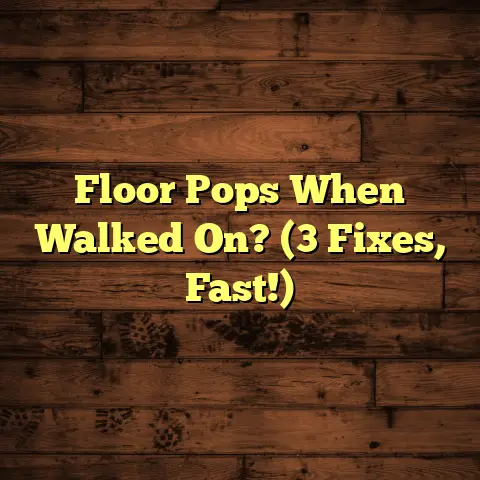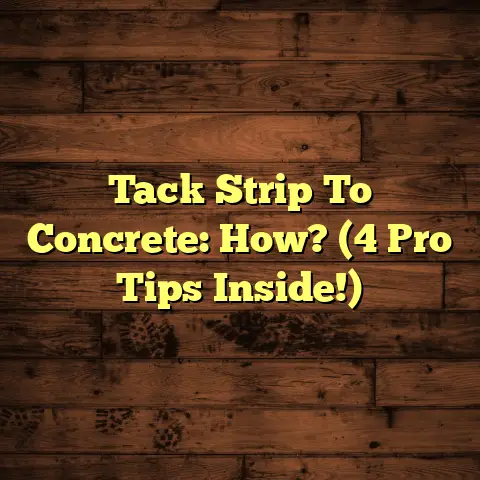Remove Glued Hardwood Floors Concrete? (Explained)
“Success is the sum of small efforts, repeated day in and day out.” – Robert Collier
Reflecting on my journey as a flooring contractor, I’m often reminded of the many projects that have shaped my skills and knowledge. One experience that stands out is the task of removing glued hardwood floors from concrete. This particular job was not only challenging but also incredibly rewarding, teaching me valuable lessons about the intricacies of flooring removal. In this article, I aim to share my experiences, insights, and practical tips to help you navigate this process with confidence and clarity.
Assessing the Situation
Before diving into the removal process, I always take a moment to assess the situation. Understanding the specifics of the flooring can make a significant difference in how I approach the task.
Identifying the Type of Adhesive
The first step involves determining whether the hardwood is indeed glued down. A simple visual inspection can help. If the hardwood is firmly attached with no loose spots, it’s likely glued. But there’s more to consider. What type of adhesive was used? Some adhesives are stronger than others, which can influence the difficulty of removal.
To get a better sense of what I’m dealing with, I often look for signs of damage or deterioration. Are there soft spots in the hardwood? Is there any moisture present? These factors can indicate potential complications during removal.
Preparing for Challenges
Once I’ve assessed the situation, I mentally prepare for potential challenges. Perhaps there will be unexpected damage to the concrete or stubborn adhesive that won’t come off easily. I remind myself that patience and persistence are key.
Tools and Preparation
Having the right tools is essential for a successful removal. Over the years, I’ve accumulated a toolkit that includes everything I need for this kind of project:
- Pry Bar: This tool is essential for lifting hardwood planks without causing damage.
- Utility Knife: A utility knife helps cut through any stubborn adhesive that may be holding the planks down.
- Floor Scraper: This is invaluable for scraping up glue remnants left on the concrete surface.
- Heat Gun: A heat gun can soften adhesives, making it easier to lift planks.
- Safety Gear: Safety should always be a priority. I wear gloves, goggles, and a mask to protect myself from dust and debris.
Setting Up the Workspace
Preparation also involves clearing the workspace. I remove all furniture, rugs, and other items from the room to ensure plenty of room to maneuver. This not only makes the job easier but also protects my clients’ belongings from any unintended damage.
The Removal Process
Once everything is ready, it’s time to get to work. In my experience, following a systematic approach makes the removal process smoother and more efficient.
Start at a Corner
I usually begin at an edge or corner of the room. This gives me a good starting point for prying up the first plank. If it comes up easily, I continue along that row. However, if I encounter resistance, I don’t force it; instead, I take a moment to reassess.
Cutting Through Adhesive
If I run into stubborn spots, I use my utility knife to cut through any adhesive between planks. The goal is to create a clean break that allows me to lift the planks without damaging them.
Using the Heat Gun
For particularly tough sections, applying heat can work wonders. I carefully use the heat gun to soften the glue, being cautious not to overheat or burn the wood. It’s essential to keep the gun moving to avoid creating hot spots.
Scraping Up Residue
After removing planks, there’s usually leftover glue on the concrete. The floor scraper becomes invaluable at this point. I make sure to scrape away as much adhesive as possible to avoid issues when installing new flooring.
Challenges Faced
While removing glued hardwood floors can be straightforward, I’ve faced my fair share of challenges along the way.
Stubborn Adhesives
One job took place in an older home where the adhesive had deteriorated over time, making it almost impossible to lift the planks without breaking them. The hardwood could only be removed in small sections, leading to frustration and additional labor hours. It required extra effort and patience as I worked methodically to avoid damaging the underlying concrete.
Concrete Damage
Another common issue is damage to the concrete itself during removal. I’ve had situations where chunks of concrete came up with the flooring. To address this, I learned to keep a patching compound handy for repairs.
When addressing damaged concrete, I make sure to evaluate the extent of the damage before applying any patching compound. If it’s a small hole or crack, I can typically fill it in quickly. However, larger areas may require more extensive repair work.
Cost Considerations
Accurate cost estimation is essential when budgeting for a flooring project. Using FloorTally has been a game-changer in this area. The platform provides real-time local material and labor rates, enabling me to give clients realistic budgets from the start.
Real-Life Example
For instance, in one project where I had to remove glued hardwood floors from a 1,000 square foot area, FloorTally helped me estimate costs related to labor and disposal fees accurately. The estimates provided were instrumental in developing a clear financial plan for my clients.
Here’s a breakdown of what those costs looked like:
- Labor Costs: Based on local rates, I estimated $2 per square foot for removal.
- Disposal Fees: The local waste management facility charged $150 for disposal of old flooring materials.
- Patching Compound: For any concrete repairs, I budgeted around $50 for materials.
This transparency has built trust with my clients, who appreciate knowing what to expect from the financial side.
Tips for Success
Based on my experiences over the years, here are some valuable tips that can help you successfully remove glued hardwood floors:
Take Your Time
Rushing through a project can lead to mistakes or damage that could have been avoided with a little more care. It’s important to work slowly and methodically.
Stay Organized
Keeping your tools and materials organized can save you time and frustration during the removal process. Designate specific areas for each tool and keep everything within reach.
Be Prepared for Surprises
It’s not uncommon to uncover hidden issues once you start removing flooring. Water damage or pest infestations may lie beneath your hardwood floor. Being prepared for these surprises will help you respond effectively.
Use Adhesive Remover
If you’re struggling with leftover glue after removing planks, consider using a commercial adhesive remover designed specifically for this purpose. These products can greatly simplify your cleanup efforts.
Addressing Concrete Damage
When dealing with concrete damage during removal, it’s essential to address these issues before proceeding with new flooring installation.
Repairing Concrete Damage
I typically fill in any holes or uneven spots with a concrete patching compound. When applying it, I follow these steps:
- Clean the Area Thoroughly: Remove any debris or dust from the damaged area.
- Mix the Compound: Prepare the patching compound according to package instructions.
- Apply Evenly: Use a trowel or putty knife to spread the compound evenly over the damaged area.
- Smooth It Out: Ensure that it’s level with the surrounding concrete.
- Cure Properly: Allow sufficient time for it to cure before laying new flooring on top.
Comparing Removal Options
Over time, I’ve tried various methods for removing glued hardwood floors, and each comes with its pros and cons:
Manual Removal
This method requires physical effort but gives you more control over the process. It’s ideal for smaller areas where precision is key.
Mechanical Removal
Using a floor scraper machine can speed things up significantly but may cause damage if not handled carefully. In larger spaces, this method can be quite effective when time is of the essence.
Chemical Methods
Adhesive removers can be effective but may require additional cleanup afterward. If you opt for this route, make sure you have adequate ventilation and protective gear.
I generally prefer manual removal for smaller areas where precision is crucial while mechanical methods are better suited for larger spaces where efficiency is needed.
Personal Anecdotes
My experiences have not only shaped my technical skills but also my understanding of client relationships and expectations.
A Memorable Client Interaction
I recall one particular job where a client was anxious about removing her old hardwood floors. She had inherited her home from her grandmother and was emotionally attached to every detail. I took extra time to explain each step of the process and reassure her that we would take care of her home as if it were our own.
When we finally removed the flooring and revealed an unexpected water-damaged section of concrete underneath, we discussed her options openly and honestly. Together we decided on repairs that fit her budget while still addressing the underlying issues effectively.
This experience reinforced my belief that communication is key in building trust with clients during challenging projects like these.
Environmental Considerations
In today’s world, many homeowners are increasingly interested in sustainable practices. When it comes to flooring removal, there are ways to minimize environmental impact:
- Recycling Old Flooring: Many local recycling centers accept old hardwood floors for repurposing.
- Choosing Eco-Friendly Adhesives: When installing new flooring, consider using low-VOC adhesives that are better for indoor air quality.
- Proper Disposal: Ensure you follow local regulations regarding waste disposal to prevent environmental harm.
Conclusion
Removing glued hardwood floors from concrete can be quite a challenge, but with the right tools, techniques, and mindset, it’s entirely manageable. My experiences over the years have taught me valuable lessons that I hope will help you in your own projects.
Remember that every challenge presents an opportunity to learn and grow as a contractor. Embrace each step of the process with confidence and curiosity. With careful planning and execution, you’ll find success in even the most demanding flooring projects.
If you ever find yourself facing a similar situation, remember that knowledge gained from past experiences will guide you toward effective solutions. Happy flooring!





